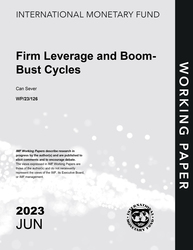
Firm Leverage and Boom-Bust Cycles
Firm Leverage and Boom-Bust Cycles
READ MORE...
Volume/Issue:
Volume 2023
Issue 126
Publication date: June 2023
ISBN: 9798400245282
$20.00
Add to Cart by clicking price of the language and format you'd like to purchase
Available Languages and Formats
| English |
Prices in red indicate formats that are not yet available but are forthcoming.
Topics covered in this book
This title contains information about the following subjects.
Click on a subject if you would like to see other titles with the same subjects.
Labor , Economics- Macroeconomics , Money and Monetary Policy , Economics / General , Firm leverage , firm debt , household debt , leverage cycles , employment , investment , boom-bust cycles , ORBIS , leverage buildup , employment growth , leverage cycle , growth cycle , cycles in the aftermath , Business cycles , Credit , Consumer credit , Credit booms , Europe , Global
Also of interest
Summary
This paper explores the dynamic relationship between firm debt and real outcomes using data from 24 European economies over the period of 2000-2018. Based on macro data, it shows that a rise in credit to firms is associated with an increase in employment growth in the short-term, but employment growth declines in the medium-term. This pattern remains similar, even when the changes in credit to households are accounted for. Next, using data from a large sample of firms, it shows that firm leverage buildups predict similar boom-bust growth cycles in firm employment: Firms with a larger increase in leverage experience a boost in employment growth in the short-term, but employment growth decreases in the medium-term. Relatedly, the volatility of employment growth increases in the aftermath of firm leverage buildups. Finally, this paper provides suggestive evidence on the role of a financial channel in the relationship between firm leverage buildups and employment growth. The results show that a rise in firm leverage is associated with a persistently higher debt service ratio, pointing the drag on finances. Consistently, boom-bust growth cycles in the aftermath of firm leverage buildups are not limited to employment growth, but are also pronounced for investment. Moreover, the medium-term decline in firm employment growth as predicted by leverage buildups becomes even larger if aggregate financial conditions tighten. The findings are in favor of “lean against the wind” approach in policy making.
Copyright © 2010 - 2025
Powered by:
AIDC



